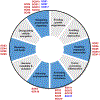Emerging Role of SOX Proteins in Breast Cancer Development and Maintenance
- PMID: 31069617
- PMCID: PMC6790170
- DOI: 10.1007/s10911-019-09430-6
Emerging Role of SOX Proteins in Breast Cancer Development and Maintenance
Abstract
The SOX genes encode a family of more than 20 transcription factors that are critical regulators of embryogenesis and developmental processes and, when aberrantly expressed, have been shown to contribute to tumor development and progression in both an oncogenic and tumor suppressive role. Increasing evidence demonstrates that the SOX proteins play essential roles in multiple cellular processes that mediate or contribute to oncogenic transformation and tumor progression. In the context of breast cancer, SOX proteins function both as oncogenes and tumor suppressors and have been shown to be associated with tumor stage and grade and poor prognosis. Experimental evidence demonstrates that a subset of SOX proteins regulate critical aspects of breast cancer biology including cancer stemness and multiple signaling pathways leading to altered cell proliferation, survival, and tumor development; EMT, cell migration and metastasis; as well as other tumor associated characteristics. This review will summarize the role of SOX family members as important mediators of tumorigenesis in breast cancer, with an emphasis on the triple negative or basal-like subtype of breast cancer, as well as examine the therapeutic potential of these genes and their downstream targets.
Keywords: Breast cancer; Cancer stem cells; EMT; Oncogene; Signaling; Sox.
Figures



References
-
- Siegel RL, Miller KD, Jemal A. Cancer statistics, 2018. CA Cancer J Clin. 2018;68(1):7–30. - PubMed
Publication types
MeSH terms
Substances
Grants and funding
LinkOut - more resources
Full Text Sources
Medical
Miscellaneous

